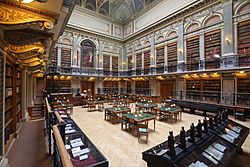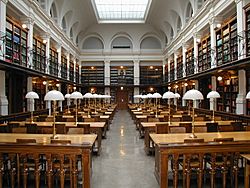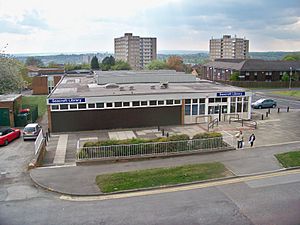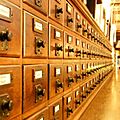Library facts for kids


A library is a place where many books are kept. Most libraries are public and let people take the books to use in their home. Most libraries let people borrow books for several weeks. Some belong to institutions, for example, companies, churches, schools, and universities. Also a person's bookshelves at home can have many books and be a library. The people who work in libraries are librarians.
Other libraries keep famous or rare books. There are a few "Copyright libraries" which have a copy of every book which has been written in that country. Some libraries also have other things that people might like, such as magazines, music on CDs, or computers where people can use the Internet. In school they offer software to learn the alphabet and other details.
A library is not a bookstore (a store that sells books).
Contents
Public libraries
Many places have a public library, where anybody can join if they live in the area. With a library card, people can borrow books and take them home for several weeks. It does not cost money to get a library card at most public libraries.
Books are kept on shelves in a special order so they are easy to find. Public libraries have stories and books about lots of things. Many public libraries have books and CDs about learning English. Stories are kept in alphabetical order by the last name of the person who wrote them, the author. Books about other things are often given a special number, that refers to what they are about. They are then put on the shelf in number order. One number system used by many libraries is the Dewey decimal system.
Academic libraries
Many colleges and universities have large academic libraries. These libraries are for the use of college students, professors, and researchers. Academic libraries are used mainly for doing research like studying the solar system or how earthquakes happen. These libraries do not have the same types of books you would find in a public library. They usually do not have fiction books or books for children (unless they are being studied). Academic libraries can have many books, sometimes more than a million.
Special libraries
Special libraries are those libraries that are not public libraries or academic libraries. They are usually small. Many times a special library holds books on a particular subject or even a special kind of book. Some special libraries keep just old books or books by Shakespeare. A special library can be owned by a business for use only by that business. For example, Disney World in Orlando has its own library that is not open to the public but for the use of the people who work for the company.
Librarians
A librarian is a person who works in a library. Librarians help people find books and information. They can teach people how to find books and use the library. A professional librarian is a person who went to school to study library science. They can earn a degree called a Masters in Library Science.
History
The earliest known library was discovered in Iraq and belonged to the ancient civilization in Sumer. They didn't used paper books but instead wrote everything on clay tablets using a style of writing called cuneiform. These tablets are over 5,000 years old. The Library of Alexandria, in Egypt, was the largest and most important library of the ancient world. It was destroyed when the Romans conquered Egypt in 30 BC. Rome’s first public library was established by Asinius Pollio who was a lieutenant of Julius Caesar. Eventually Rome would build 28 public libraries within the city. When the Roman Empire fell in 330 AD, many books went east to the city of Byzantium where a large library was built. Other libraries were built in monasteries and public homes.
Libraries began to appear in many Islamic cities where science and philosophy survived after the fall of the Roman Empire. Surprisingly, Christian monks and Islamic libraries exchanged books to copy. These books eventually made there way back to the West and helped start the Renaissance. European universities began the practice of creating academic libraries at this time for the use of their students.
The 17th and 18th centuries was called "The Golden Age of Libraries" when national libraries were being created all over Europe. These national libraries collected books that were published in their own country as well as some books from other countries.
Images for kids
-
The Library of the Palais Bourbon in Paris
-
Duke Humfrey's Library, Oxford, England
-
The Sistine Hall of the Vatican Library.
-
The State Library Victoria's La Trobe Reading Room
-
The round reading room of Maughan Library, the main university library of King's College London, London, England
-
The Robarts Library at the University of Toronto, Canada
-
A children's library in Montreal, Quebec, Canada in 1943
-
Interior of the National Library of Finland in Helsinki, Finland
-
National Library of Wales, Aberystwyth
-
Raczyński Library, the public library of Poznań, Poland
-
A community library in Ethiopia
-
Bates Hall, the main reading room of the Boston Public Library, Boston, Massachusetts, United States
-
Main reading room of the New York City Public Library on 5th Avenue c. 1910–1920
-
Quaid-e-Azam Library in Bagh-e-Jinnah, Lahore, Pakistan
-
Butler Library at Columbia University, est. 1759
-
National Library of India, Kolkata, est. 1836
-
Until the advent of digital catalogues, card catalogues were the traditional method of organizing the list of resources and their location within a large library.
-
Interior of the Bibliotheca Alexandrina, Alexandria, Egypt, showing both stacks and computer terminals
See also
 In Spanish: Biblioteca para niños
In Spanish: Biblioteca para niños




























